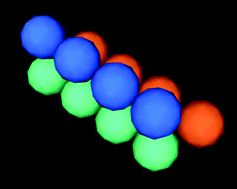Sheared edible oils studied using dissipative particle dynamics and ultra small angle X-ray scattering: TAGwood orientation aggregation and disaggregation
Abstract
Previous work on the computer simulation of edible fats and oils showed that triglyceride crystalline nanoplatelets (CNPs) aggregated into cylindrical structures dubbed “TAGwoods”. This was experimentally verified using Ultra Small Angle X-ray Scattering experiments. In this paper, the aggregation of these TAGwoods was studied using the fluid simulation technique, Dissipative Particle Dynamics. The intent was to predict the TAGwood aggregation structures which arise via the application of a series of shear rates, ![[small gamma, Greek, dot above]](https://www.rsc.org/images/entities/i_char_e0a2.gif) . The effect of shear on TAGwood orientational order was also investigated. Three aggregation regimes were identified: At shear rates below a certain critical value, 0 <
. The effect of shear on TAGwood orientational order was also investigated. Three aggregation regimes were identified: At shear rates below a certain critical value, 0 < ![[small gamma, Greek, dot above]](https://www.rsc.org/images/entities/i_char_e0a2.gif) <
< ![[small gamma, Greek, dot above]](https://www.rsc.org/images/entities/i_char_e0a2.gif) t aggregation was enhanced. The value of the critical shear rate depended on the size of the CNPs. With large CNPs possessing a side length of ∼500 nm, the critical shear rate was
t aggregation was enhanced. The value of the critical shear rate depended on the size of the CNPs. With large CNPs possessing a side length of ∼500 nm, the critical shear rate was ![[small gamma, Greek, dot above]](https://www.rsc.org/images/entities/i_char_e0a2.gif) t ≈ 0.6 s−1. However, if the CNPs were smaller with a side length of ∼100 nm, then
t ≈ 0.6 s−1. However, if the CNPs were smaller with a side length of ∼100 nm, then ![[small gamma, Greek, dot above]](https://www.rsc.org/images/entities/i_char_e0a2.gif) t ≈ 75 s−1. For shear rates above the critical shear rate,
t ≈ 75 s−1. For shear rates above the critical shear rate, ![[small gamma, Greek, dot above]](https://www.rsc.org/images/entities/i_char_e0a2.gif) >
> ![[small gamma, Greek, dot above]](https://www.rsc.org/images/entities/i_char_e0a2.gif) t aggregation was inhibited. The USAXS data was analyzed using the Unified Fit model and the observations were in accord with the simulation results. Three regimes were identified based on the values of the linear slope P2 of the USAXS data. P2 increased as
t aggregation was inhibited. The USAXS data was analyzed using the Unified Fit model and the observations were in accord with the simulation results. Three regimes were identified based on the values of the linear slope P2 of the USAXS data. P2 increased as ![[small gamma, Greek, dot above]](https://www.rsc.org/images/entities/i_char_e0a2.gif) increased, indicating increased aggregation of the TAGwoods as the shear rate was increased. P2 ceased increasing and began to decrease when
increased, indicating increased aggregation of the TAGwoods as the shear rate was increased. P2 ceased increasing and began to decrease when ![[small gamma, Greek, dot above]](https://www.rsc.org/images/entities/i_char_e0a2.gif) ≈
≈ ![[small gamma, Greek, dot above]](https://www.rsc.org/images/entities/i_char_e0a2.gif) t. With further increases in
t. With further increases in ![[small gamma, Greek, dot above]](https://www.rsc.org/images/entities/i_char_e0a2.gif) , P2 decreased as
, P2 decreased as ![[small gamma, Greek, dot above]](https://www.rsc.org/images/entities/i_char_e0a2.gif) increased further, which is indicative of a decrease in aggregation. The orientational quadrupole order parameter, S = 〈Q33〉 = 1/2〈cos2θ − 1〉, was computed, where θ is the angle between the axis of the TAGwood and the axis of flow, and showed that, for large
increased further, which is indicative of a decrease in aggregation. The orientational quadrupole order parameter, S = 〈Q33〉 = 1/2〈cos2θ − 1〉, was computed, where θ is the angle between the axis of the TAGwood and the axis of flow, and showed that, for large ![[small gamma, Greek, dot above]](https://www.rsc.org/images/entities/i_char_e0a2.gif) , it achieved a near-maximum value. This indicates that at high shear rates, the long axis of the cylindrical TAGwoods aligns in a direction parallel to that of the fluid flow.
, it achieved a near-maximum value. This indicates that at high shear rates, the long axis of the cylindrical TAGwoods aligns in a direction parallel to that of the fluid flow.



 Please wait while we load your content...
Please wait while we load your content...